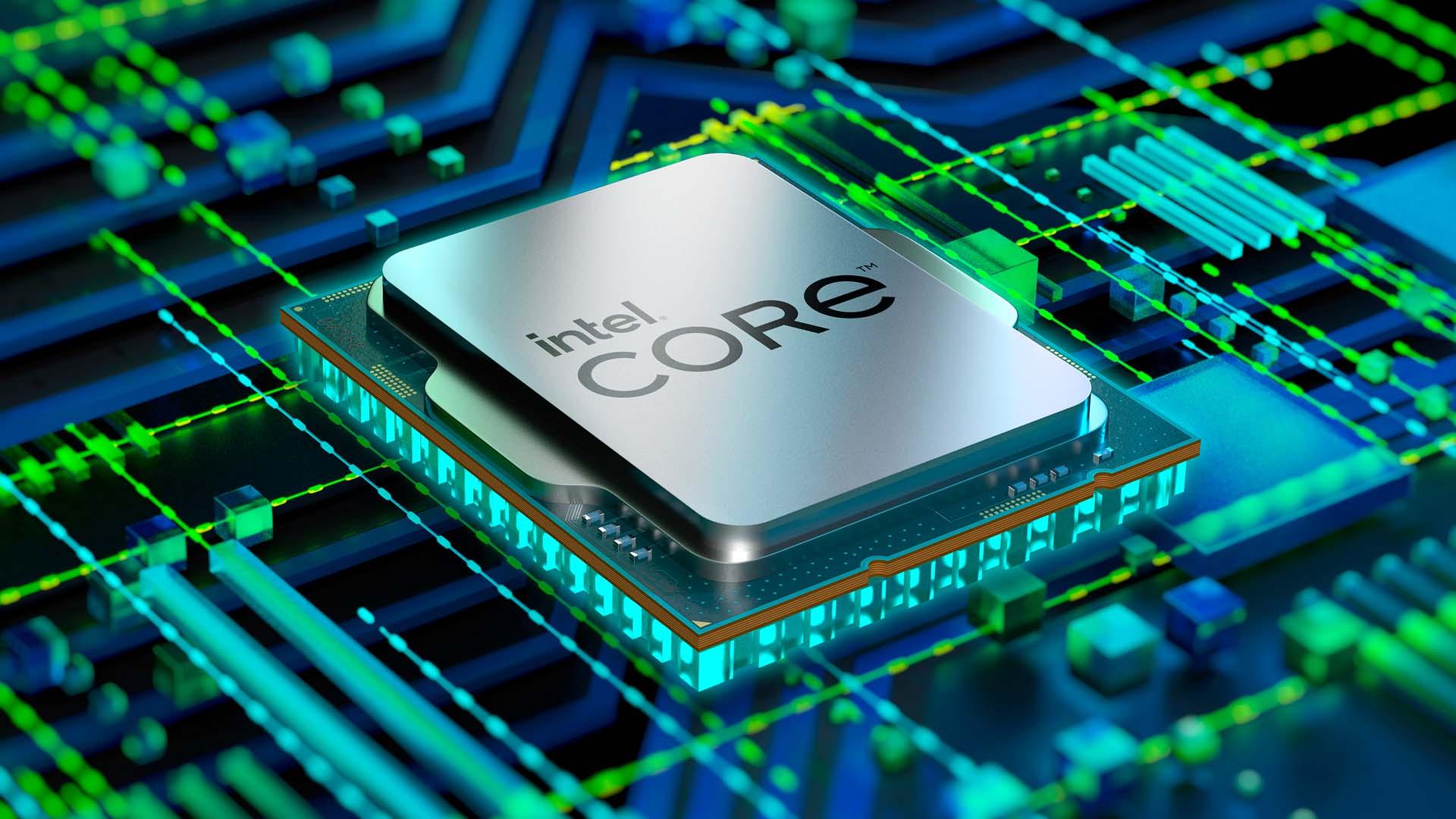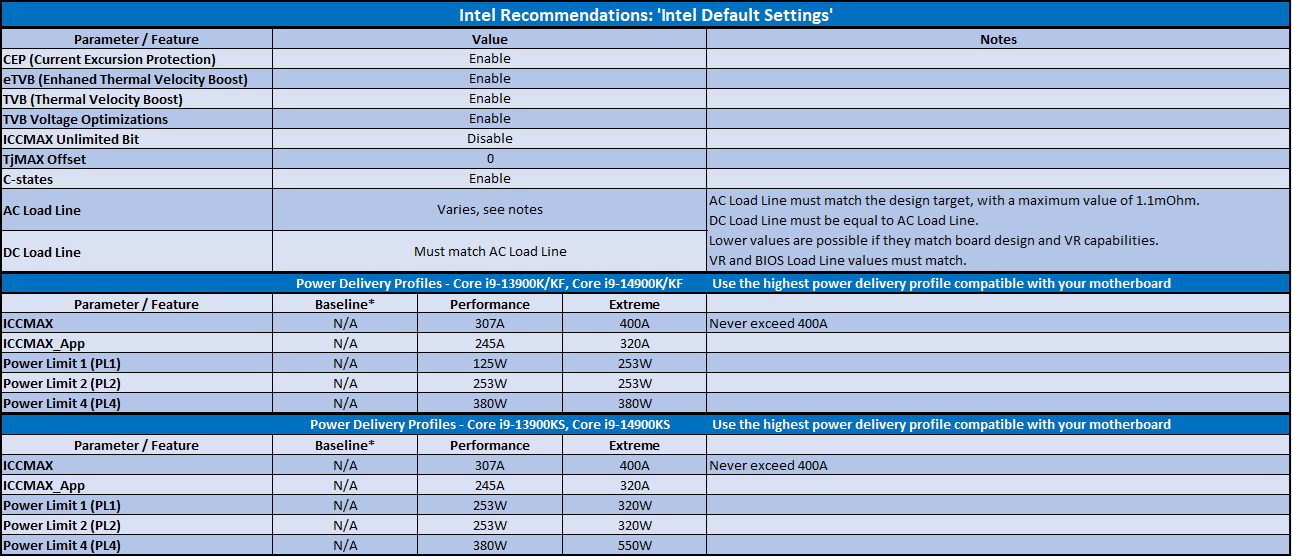Intel issues official statement on Core K-series crashes: stick to Intel's official power profiles
'Baseline Settings' aren't official Intel settings.

Intel has released a statement asking end-users and platform manufacturers to use its official power profiles that have been (or are being) added to many BIOSes. The announcement comes after a wave of reports of Intel's 13th and 14th Generation Core desktop processors crashing during certain workloads.
While the extent of the crashing issues is currently unknown, many surmise that the chips are unstable under high loads due to non-standard power settings implemented by motherboard makers. In response, motherboard vendors released BIOS settings with 'Intel Baseline Profiles' that were meant to improve stability at the cost of performance, but those profiles often don't follow Intel's actual default power profile settings.
Intel has now clarified that it recommends using the 'Intel Default Settings' profile for the most basic level of performance on lower-end boards, but it doesn't recommend them for the K-Series processors with robust motherboards. Instead of limiting CPU power supply on high-end mainboards, Intel advises using its Performance or Extreme profiles, which are good for processors like the Core i9-13900K/KF, Core i9-14900K/KF, Core i9-13900KS, and Core i9-14900KS. These profiles come in different levels based on the motherboards' power delivery capabilities, as listed in the table below.
By recommending platform developers implement the highest power delivery profile compatible with their motherboards, Intel ensures that its CPUs get enough power and the end user gets the full performance its processors are capable of, which is in line with Intel's warranty terms.
Intel's statement reads as follows:
"Several motherboard manufacturers have released BIOS profiles labeled ‘Intel Baseline Profile’. However, these BIOS profiles are not the same as the 'Intel Default Settings' recommendations that Intel has recently shared with its partners regarding the instability issues reported on 13th and 14th gen K SKU processors.
These 'Intel Baseline Profile' BIOS settings appear to be based on power delivery guidance previously provided by Intel to manufacturers describing the various power delivery options for 13th and 14th Generation K SKU processors based on motherboard capabilities.
Get Tom's Hardware's best news and in-depth reviews, straight to your inbox.
Intel is not recommending motherboard manufacturers to use ‘baseline’ power delivery settings on boards capable of higher values.
Intel’s recommended 'Intel Default Settings' are a combination of thermal and power delivery features along with a selection of possible power delivery profiles based on motherboard capabilities.
Intel recommends customers to implement the highest power delivery profile compatible with each individual motherboard design as noted in the table below."
Several motherboard manufacturers have released BIOS profiles labeled ‘Intel Baseline Profile’. However, these BIOS profiles are not the same as the 'Intel Default Settings' recommendations that Intel has recently shared with its partners regarding the instability issues reported on 13th and 14th gen K SKU processors. These 'Intel Baseline Profile' BIOS settings appear to be based on power delivery guidance previously provided by Intel to manufacturers describing the various power delivery options for 13th and 14th Generation K SKU processors based on motherboard capabilities. Intel is not recommending motherboard manufacturers to use ‘baseline’ power delivery settings on boards capable of higher values. Intel’s recommended 'Intel Default Settings' are a combination of thermal and power delivery features along with a selection of possible power delivery profiles based on motherboard capabilities. Intel recommends customers to implement the highest power delivery profile compatible with each individual motherboard design as noted in the table below.
Intel representative

Anton Shilov is a contributing writer at Tom’s Hardware. Over the past couple of decades, he has covered everything from CPUs and GPUs to supercomputers and from modern process technologies and latest fab tools to high-tech industry trends.
-
Marlin1975 So is toms going to retest Intel CPUs at the now "baseline" and not over clocked power ratings?Reply -
35below0 Reply
All the benchmarks are flawed now. i7 and i9 intels will lose performance after retesting. Performance they never should have had because it was unstable.Marlin1975 said:So is toms going to retest Intel CPUs at the now "baseline" and not over clocked power ratings?
Although, nothing stops users overdriving their CPUs to hell and back on their own. -
rluker5 Reply
Some are unstable. Not mine, not all, not most, some. Intel said to follow this IF you had stability issues.35below0 said:All the benchmarks are flawed now. i7 and i9 intels will lose performance after retesting. Performance they never should have had because it was unstable.
Although, nothing stops users overdriving their CPUs to hell and back on their own.
All of these guidelines are consistent with lowering and dealing vdroop under heavy load.
Apparently the motherboards power delivery at default settings is no match for i9s power consumption capabilities. -
JasonovichClone People had paid serious wonga just to have the bragging rights but now due to instability problems, those that have been affected now have useless CPU's at worse or forced to throttle down their little guzzlers into vanilla 139/149K.Reply
So disingenuous on Intel's part, they knew their processors were operating beyond their threshold and carte blanche was already in place for MB OEMs to milk it but when the faeces hit the fan.
Intel cries What No, Not our fault. They first blamed Nvidia then Jensen said No not out of memory problem, please under volt your CPU.
Not a problem Team Blue needs right now, when AMD is preparing to launch it's destroyer of worlds battleship ZEN 5. -
ingtar33 Reply
according to a pc maker, after testing 1000 intel 14th gen chips, he found only 20% of the i9 14900k/ks chips were stable out of the box with those extreme power settings.rluker5 said:Some are unstable. Not mine, not all, not most, some. Intel said to follow this IF you had stability issues.
All of these guidelines are consistent with lowering and dealing vdroop under heavy load.
Apparently the motherboards power delivery at default settings is no match for i9s power consumption capabilities.
thats a hell of a lot more then "some"
and i suggest you run your chip on prime95 for a few hours to verify it's stable. cause you only have a 1/5 chance you won that lotto. -
gggplaya Replyingtar33 said:according to a pc maker, after testing 1000 intel 14th gen chips, he found only 20% of the i9 14900k/ks chips were stable out of the box with those extreme power settings.
thats a hell of a lot more then "some"
and i suggest you run your chip on prime95 for a few hours to verify it's stable. cause you only have a 1/5 chance you won that lotto.
I believe that qualifies as "MOST" have some form of stability issue with motherboard overclock power profile.
So glad I bought a Ryzen 7800x3D. Less watts and runs much cooler. Sure it has RAM stability issues but AMD only advertises and rates it at 5200mhz speed, which runs fine. DDR5-6000 runs great on most binned chips. Anything over that is silicone lottery and they've always been up front about that. -
palladin9479 ReplyMarlin1975 said:So is toms going to retest Intel CPUs at the now "baseline" and not over clocked power ratings?
It's kind of the other way around. "Default" settings were not Intel's actual defaults and instead where the motherboard Vendors attempts at automatically overclocking. Intel is now asking to use the non-defaults because those settings come from the Intel CPU and not the motherboard BIOS.
